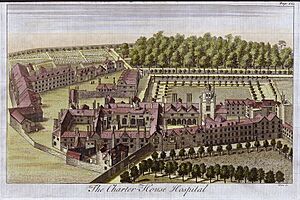Henry Levett facts for kids
Dr Henry Levett (born around 1668 – died July 2, 1725) was an important English doctor. He wrote a special paper about how to treat a serious disease called smallpox. He also worked as the main doctor at the Charterhouse in London.
Early Life of Henry Levett
Henry Levett was born around the year 1668. His father, William Levett, worked for King Charles I of England.
Henry went to Charterhouse School when he was young. Later, he studied at Magdalen College, Oxford in 1686, when he was 17 years old. He finished his studies and became a doctor, earning his M.D. degree from Oxford in 1699.
Levett's Medical Career

Dr. Levett moved to London to start his medical career. In 1707, he became a doctor at St. Bartholomew's Hospital. Then, in 1713, he also became the main doctor at the nearby Charterhouse. He helped create a strong link between these two important places.
Levett was a very innovative doctor. In 1710, he wrote a special paper about treating smallpox. He suggested using "cathartics," which are medicines that help clean out the body. He studied two cases of smallpox carefully for his paper. Another doctor, Dr. John Freind, thought Levett's work was so good that he included it in his own collection of medical writings in 1733.
It is also thought that Dr. Levett wrote a short story about another famous doctor named William Wagstaffe. This story was called "Character" and was put at the beginning of Wagstaffe's collected works in 1725. The writer of this story (likely Levett) was described as a "skillful doctor" who was also "witty and fun to talk to."
Dr. Levett and Dr. Freind were good friends with Thomas Hearne. Hearne was a person who studied old things and history. They often wrote letters to each other about their health and other topics.
Dr. Levett also paid to rebuild the doctor's house at the Charterhouse school. He lived in this house until he died. He made it very nice with oak wood panels and fancy carvings. He played a big part in shaping the early history of the Charterhouse. He also worked as the treasurer for the Royal College of Physicians. In this role, he bought special candlesticks and other items that are still kept by the college today.
Death and Memorial
Dr. Henry Levett passed away on July 2, 1725, when he was 56 years old. His wife later married the school's headmaster, Andrew Tooke.
He was buried at the Charterhouse chapel, right in front of the altar. There is a special monument there to remember him. It has a message written in Latin and shows his family's coat of arms.

